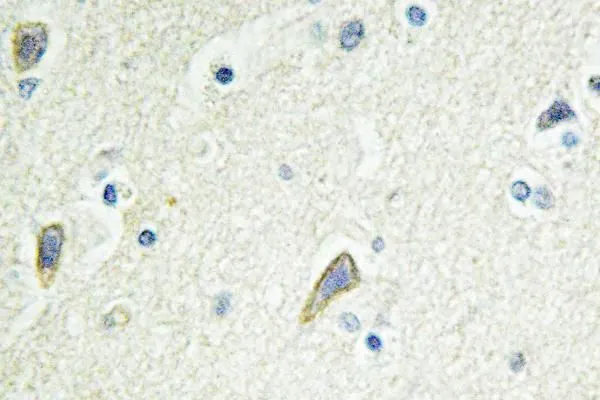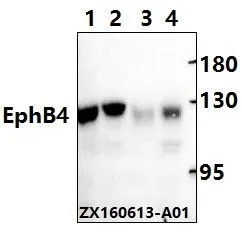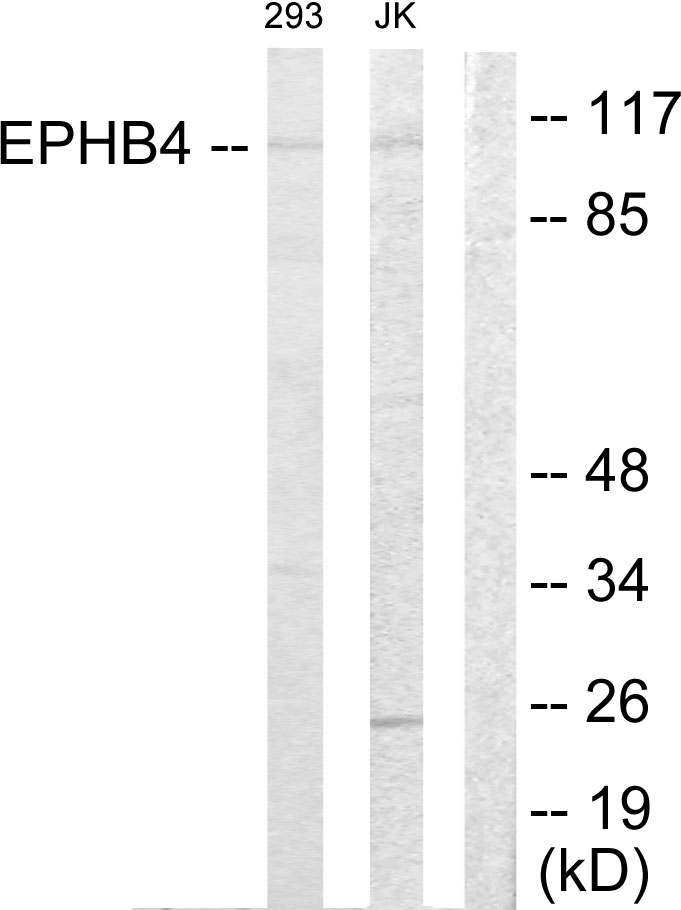
IHC-P analysis of human brain tissue using GTX66654 EphB4 antibody.
EphB4 antibody
GTX66654
ApplicationsWestern Blot, ImmunoHistoChemistry, ImmunoHistoChemistry Paraffin
Product group Antibodies
TargetEPHB4
Overview
- SupplierGeneTex
- Product NameEphB4 antibody
- Delivery Days Customer9
- Application Supplier NoteWB: 1:500-1:1000. IHC-P: 1:50-1:200. *Optimal dilutions/concentrations should be determined by the researcher.Not tested in other applications.
- ApplicationsWestern Blot, ImmunoHistoChemistry, ImmunoHistoChemistry Paraffin
- CertificationResearch Use Only
- ClonalityPolyclonal
- Concentration1 mg/ml
- ConjugateUnconjugated
- Gene ID2050
- Target nameEPHB4
- Target descriptionEPH receptor B4
- Target synonymsCMAVM2, HFASD, HTK, LMPHM7, MYK1, TYRO11, ephrin type-B receptor 4, ephrin receptor EphB4, hepatoma transmembrane kinase, tyrosine-protein kinase TYRO11, tyrosine-protein kinase receptor HTK
- HostRabbit
- IsotypeIgG
- Protein IDP54760
- Protein NameEphrin type-B receptor 4
- Scientific DescriptionEphrin receptors and their ligands, the ephrins, mediate numerous developmental processes, particularly in the nervous system. Based on their structures and sequence relationships, ephrins are divided into the ephrin-A (EFNA) class, which are anchored to the membrane by a glycosylphosphatidylinositol linkage, and the ephrin-B (EFNB) class, which are transmembrane proteins. The Eph family of receptors are divided into 2 groups based on the similarity of their extracellular domain sequences and their affinities for binding ephrin-A and ephrin-B ligands. Ephrin receptors make up the largest subgroup of the receptor tyrosine kinase (RTK) family. The protein encoded by this gene binds to ephrin-B2 and plays an essential role in vascular development. [provided by RefSeq, Jul 2008]
- Storage Instruction-20°C or -80°C,2°C to 8°C
- UNSPSC12352203






![WB analysis of Jurkat (1) and HEK293 (2) cell lysate using GTX83017 EphB4 antibody [7H4A6].](https://www.genetex.com/upload/website/prouct_img/normal/GTX83017/GTX83017_20170912_WB_w_23061322_547.webp)
![ICC/IF analysis of methanol-fixed HEK293 cells trasfected with EphB4-hIgGFc using GTX83117 EphB4 antibody [5B5]. Green : EphB4 Blue: DRAQ5 fluorescent DNA dye](https://www.genetex.com/upload/website/prouct_img/normal/GTX83117/GTX83117_20170912_ICCIF_w_23061322_375.webp)
![IHC-P analysis of human pancreas carcinoma (left) and breast carcinoma (right) tissue using GTX83333 EphB4 antibody [5B8F7].](https://www.genetex.com/upload/website/prouct_img/normal/GTX83333/GTX83333_20170912_IHC-P_w_23061322_625.webp)